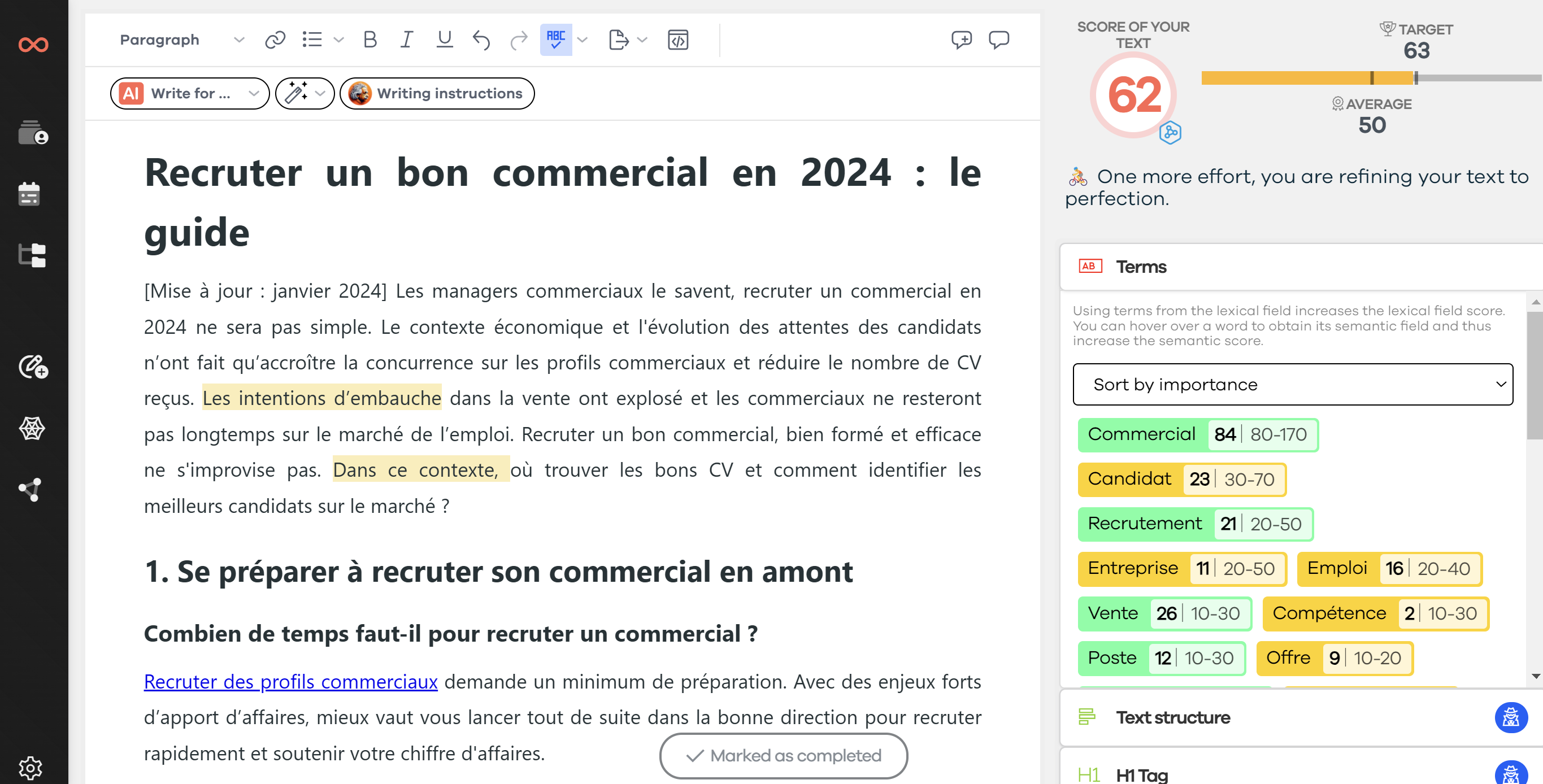You spend time crafting the content for your blog, but nobody reads it? How frustrating! So, of course, you wonder how to write a high-performing SEO article... Rest assured, there are effective ways to optimize your content and attract organic traffic to your website. In this post, I'll give you 12 tips to answer this question and help you write an SEO-friendly article that will please both your readers and search engines.
🚀 Quick read: the essentials for knowing how to write an SEO article
Here's an infographic that explains the 12 points to know for writing an SEO-friendly article.
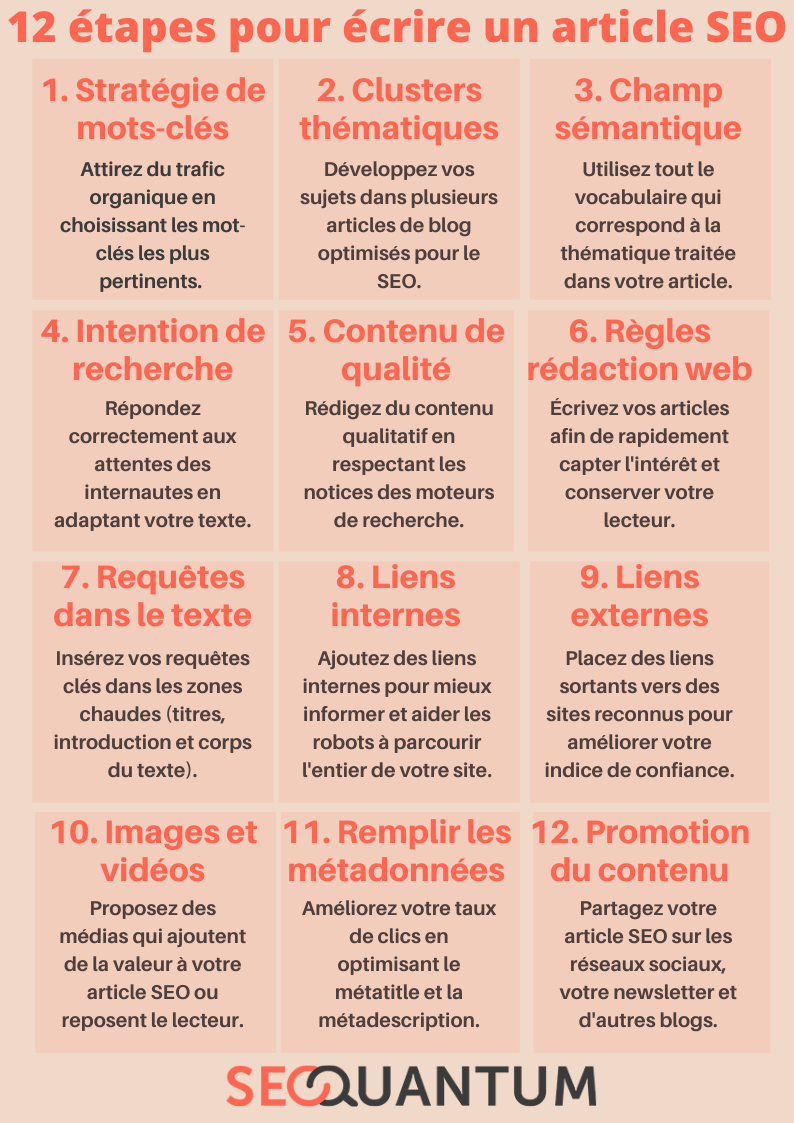
👨🏫 What is an article optimized for search engines?
Writing an SEO article (Search Engine Optimization) means creating textual content intended for publication on your blog. For users to find it, you must comply with the SEO guidelines proposed by Google, Bing, Yahoo, and other search engines.
As a result, if you want to write a good SEO text, you must optimize it according to the criteria of organic search. However, even if you want to know how to write an SEO article, never lose sight of your primary target: the user! Indeed, if you write only for indexing robots, your text is likely to be unreadable and quickly deter your reader.
👀 Why is writing an SEO-friendly article important?

By optimizing your text's SEO, you have a chance to appear at the top of search engine results pages (SERP) and, therefore, be read! Isn't that your primary goal when writing an article? Be aware that over 90% of users don't go to the second page of Google. Doing everything possible to be among the top ten results is essential if you want to be visible on the Web.
Thus, by writing a good SEO-friendly article, you have the opportunity to generate significant organic traffic to your site. However, I remind you that writing an optimized text for SEO is unfortunately not enough to stand out from your competition. Indeed, you must also work on the other pillars of SEO such as strategy, technique, and popularity.
💥 How to write an SEO article in 12 steps?
To avoid over-optimizing your content and keeping it readable for humans, I invite you to discover the 12 steps that I believe are essential for writing a quality SEO article. Before you start writing, you need to set up a content strategy. You will then be able to refine your texts for search engines and users.
1. Find the right keywords
Before you even start writing content for your blog, you will research the keywords you want to work on. It's not necessary to focus only on queries with high search volumes, even though you want potential organic traffic. However, know that even by working on long-tail keywords, you have a chance to rank for many keywords.
To find the right keywords, you can use SEO tools, browse search engine results pages, or analyze your SEO competition. Once this work is done, I recommend grouping this information in a content calendar. This will help you guide your editorial team and plan your publications in the long term.
2. Consider keyword clustering
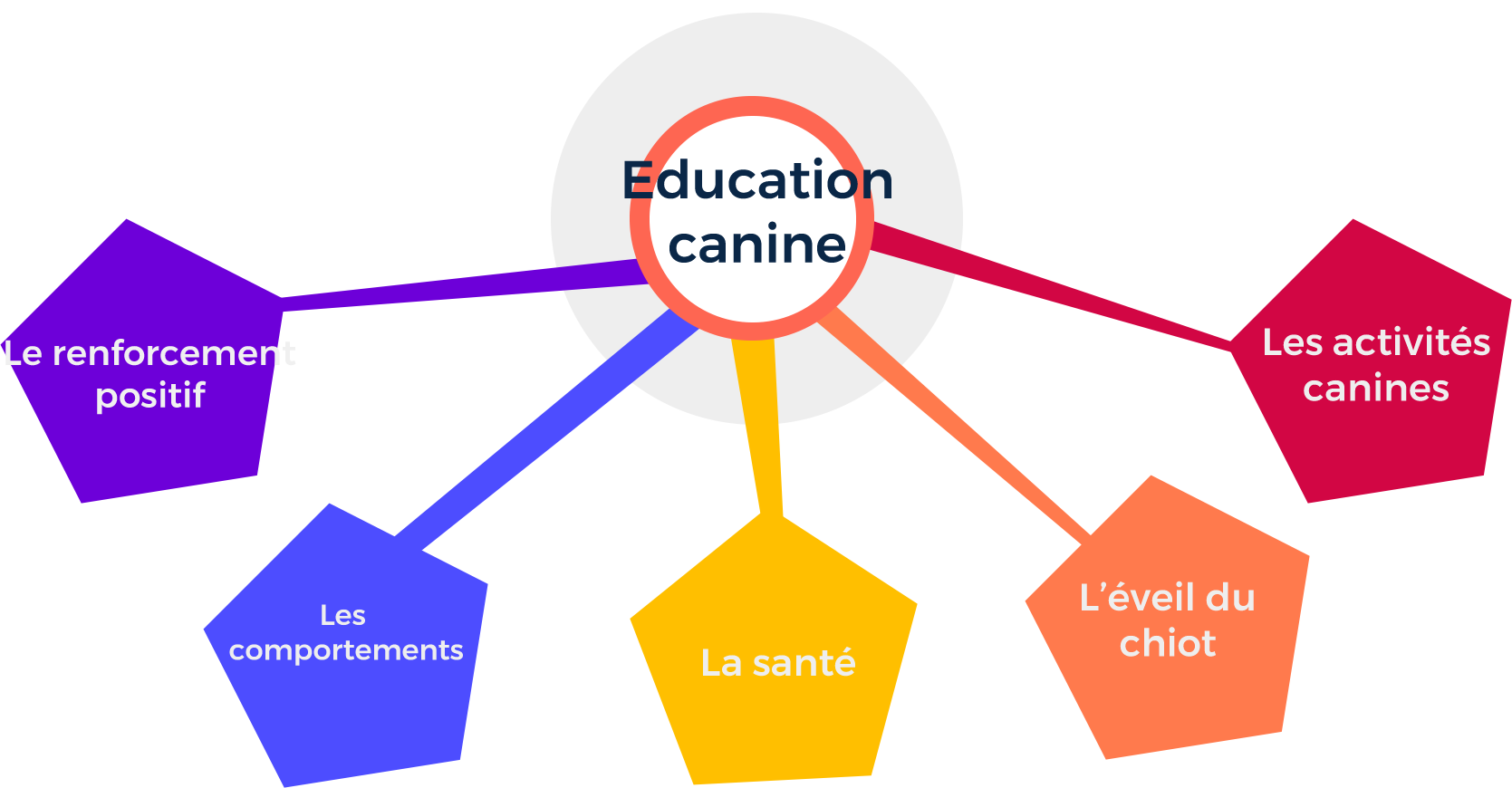
Now that you know the queries you want to be visible on Google, you can expand your topics to cover them comprehensively. By creating keyword clusters, you ensure that you fully meet the needs of users and retain your traffic by redirecting them to your related pages.
From an SEO perspective, this strategy is also highly relevant. Indeed, if your blog contains numerous articles covering a theme as a whole, you demonstrate to search engines that you are an expert in the subject. As a result, when a Googler searches for something related to your area of expertise, you are more likely to be favored.
3. Expand the semantic field
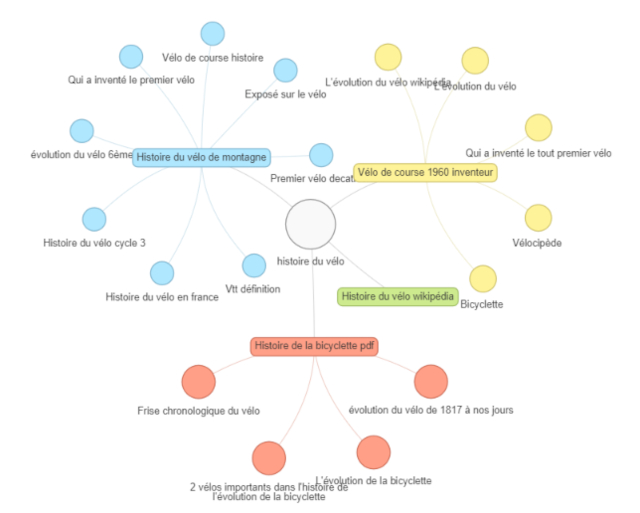
Writing an SEO article doesn't mean you have to continually write the same keyword! In fact, it's quite the opposite... For the reader's comfort and the proper understanding of search robots, you will instead try to use the entire lexical and semantic field of the subject discussed.
Moreover, using varied vocabulary allows you to rank for a large number of queries. Improving your content with semantics is therefore an asset that allows you to significantly increase your visibility on the Internet and attract more visitors to your blog.
4. Address search intent
The last essential step before starting to write your SEO article is to understand the user. Try to determine the user's intent when searching on Google. Do they want information, do they want to make a purchase, or are they looking for a comparison to help them make a decision?
To become aware of search intent, I think the easiest way is to spend some time on the Google SERP. This way, you can already see the displayed results and understand which needs they address. Then, you can consult the proposed pages to discover how the content has been optimized for that particular intent.
5. Write high-quality content
You can finally start writing and implementing everything you've analyzed beforehand! Your goal now is to provide high-value content to stand out from your competition, meet your reader's expectations, and send a positive message to search engines.
In 2020, Google provided very clear information on this subject in their EAT evaluation guide (Expertise, Authoritativeness, Trustworthiness). If you are proficient in English, here is the updated document from October 2021: Google General Guidelines.
6. Follow web writing rules
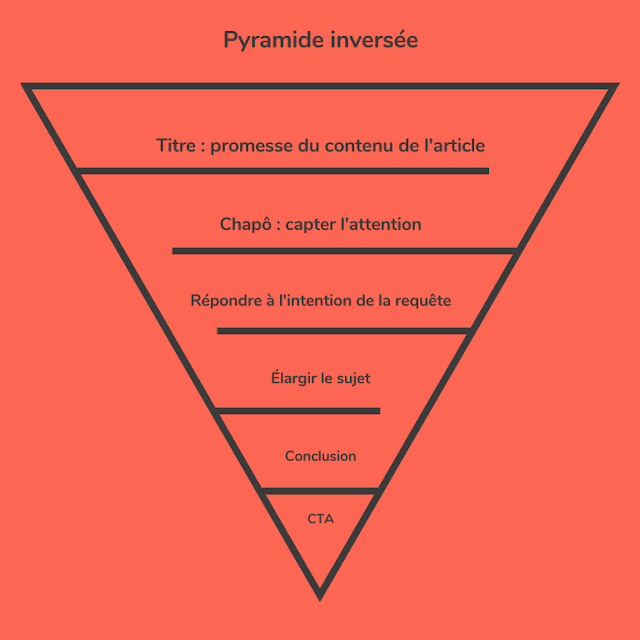
When writing for the web, you need to understand the specifics of digital reading. To begin with, know that mobile users (users on mobile screens, i.e., smartphones and tablets) are now the majority. The reading format is therefore reduced, and you must adapt your writing to remain readable.
Moreover, sources of distraction are numerous, and competition is intense. As a result, you absolutely want to quickly engage your readers and captivate them to continue reading. If you don't think you can do it, you might consider taking a web writing course or hiring an SEO copywriter.
7. Place your queries in the text
Your text is finally written! You are satisfied with its quality, have followed the rules of writing on the Internet, addressed search intent, and developed the lexical field. Congratulations, you are just a few steps away from being able to publish it! To further improve its readability and promote your SEO, you will integrate your main and secondary queries into the "hot zones".
To optimize an SEO article, it is considered important to place keywords in the URL, the title tags (H1), subheadings (H2, H3, etc.), the introduction, and the conclusion. First, this allows the reader to quickly find their way. Moreover, indexing robots seem to give a lot of value to these locations.
8. Add internal links
Including links in your SEO article that redirect to other pages on your site is an optimization element you should not overlook. Internal linking has a significant SEO power, as it not only offers additional information to your visitor but also allows search engine robots to crawl the pages you want to highlight.
Of course, this should not be done randomly! You will carefully consider link anchors, provide details on the topic discussed in your SEO article, and share the "juice" to specific pages. By doing so, you improve your organic search ranking and retain your traffic.
9. Include external links
Out of fear of losing their visitors, bloggers often hesitate to place in their SEO articles links pointing to other websites. It's legitimate to think this way, but it neglects an SEO criterion: trust. Indeed, if you offer quality additional information, Google will think highly of it.
You must understand that the primary goal of search engines is to provide results that meet users' intentions. So, if the outbound links you present are legitimate, the message is positive. And, to avoid losing your traffic, you can force the link to open in a new browser window.
10. Integrate visual and/or video media
Even though we're talking about textual content, images and videos are important for your SEO. First, you create a chance to appear in related searches (films and photos). Moreover, I believe there are two distinct objectives for inserting media into your SEO article.
2. Rest the reader: if you tend to write long articles, your audience may get tired of reading your text. An illustration image is a good way to offer them a break!
11. Optimize your metadata
Metadata is the information displayed on search engine results pages. We distinguish between meta-title and meta-descriptions, and each of these elements should contain your main query.

- Meta-description: although it doesn't have a direct influence on SEO, the description helps improve your click-through rate, which indirectly improves your Google ranking.
12. Promote your content
You have finally finished your SEO article and published it on your blog! Now, instead of waiting with your arms crossed for it to be indexed and appear in the SERP, I strongly recommend promoting it on other communication channels. This will allow you to quickly attract traffic and, if your content is good, be shared by those who follow you.
- Newsletter: even if you don't have thousands of contacts, let them know that a new article has been published on your website.
- Other sites: take advantage of your article to suggest other bloggers mention it on their website. This way, you have the opportunity to get a backlink for free.
🎬 Conclusion
If you follow these 12 content optimization points for your blog, you are highly likely to be visible on search engines. I would add that to know how to write an SEO article, you should always think about what you would like to receive as information when reading a text. Moreover, your knowledge of the functioning and expectations of search engine algorithms is essential for attracting organic traffic.
And you? How do you write an SEO-friendly article? Do you have other tactics than those described in this blog post? Don't hesitate to let us know; we'd be delighted to learn more about this topic!
Need to go further?
If you need to delve deeper into the topic, the editorial team recommends the following 5 contents:

